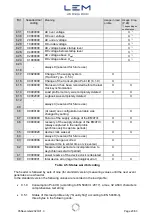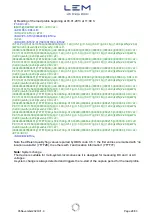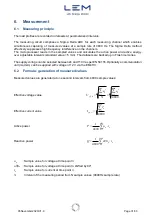
05November2020/V1.0
Page 25/33
4.2.7 Recognition of the traction power system
The recognizes the currently applied traction power system.
A traction power system is in this sense always understood as a combination of the supply frequency
(DC or AC-frequency) and the supply voltage.
Rated voltage values (according to EN 50163:2004) of 600V/750V (DC), 1500V (DC), 3000V (DC),
15.000V (16.7 Hz AC), and 25.000V (50Hz AC) can be distinguished.
Tolerances between Umin1 and Umax2 according to EN 50163 are considered as valid for the
permanent operation, except for 750V networks where U
max1
limit is kept in order not to have an
overlap with U
min1
from the 1500V network.
Note:
According to the tolerances defined in EN 50163 for permanent operation, a distinction between the
nominal voltages 600V and 750V (DC) is not possible in this context.
In addition to the detection of voltage system, the recognizes the currently applied supply
frequency. For AC frequencies a valid deviation from the nominal frequencies defined in EN 50163 in
a range of ± 9% is assumed.
A system is detected only when voltage and frequency match the expected combination. E.g.
detection of frequency without voltage or AC voltage without matching frequency is flagged as
“undefined system”
To avoid unnecessary detection of short-term irregular supply situations in this context, the applied
traction system is recognized basically with a bounce time of 10s. This applies both in recognizing the
power system after idle state (i.e. after the operation without recognized traction power system) and
after a change in the system for multi-system vehicles. After such a system change, the previously
recognized system is assumed immediately to be no longer active after recognition of the new system.
In this respect, it is ensured that in normal operation only one system is recognized as valid.
Note:
"Lab situations
”, such as the simultaneous operation with AC and DC, may cause detection of two
systems simultaneously, according to the former traction type definition C.5.2.
According to the new traction type definition (EN 50463-3:2017) conflicting detections are flagged as
“undefined system”.
Damage to the is impossible in such a case, if the maximum input values of voltage and
current for the specific device design are not exceeded.
The first occurrence of one of the following events causes a previously recognized traction system to
be assumed as no longer active:
•
change to a different system (see above)
•
a loss of a valid frequency detection, if previously an AC system has been detected
•
a decrease of the traction supply voltage below U
min1
(to EN 50163) for more than 120 seconds if
previously a valid supply system has been detected
(Note: The duration of 120 seconds corresponds to the regulations of EN 50163)
•
a decrease in the supply voltage below 30% of the previously detected supply voltage























